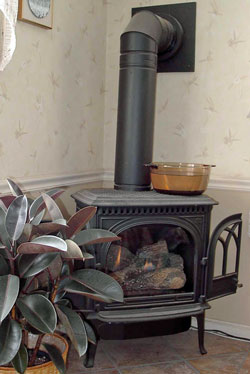Heating our home
 ©Janet Allen
©Janet AllenOur gas stove (the brown bowl is water to increase humidity)
Although we never planned it, we've ended up with zoned heating. This works out really well especially since we now have an empty nest and use even less of the house than we did before.
Except for sleeping upstairs at night, when we want the house cooler anyway, we basically just heat the family room/office, bathroom and kitchen part of the downstairs, which are the only parts of the house we live in anyway.
Before installing this stove in the family room, we had to use our whole-house gas forced air furnace to heat the entire house to be comfortable in the living area. To make things worse, the part of the house we spend 90% of our time is an addition that didn't have adequate vents from the furnace, so the rest of the house had to be relatively warmer to make this area barely comfortable. We often didn't even use the family room for much of the winter.
Now with the gas stove, we pretty efficiently heat the small part of the house we live in to a reasonable temperature and leave the thermostat set in the rest of the house to about 52°. A huge savings of energy, and we're even more comfortable than we had been before.
We've had the stove more than 10 years now, and it has been trouble-free. (Of course, as with any gas furnace, we get it serviced annually.) Even better, I really enjoy sitting in front of the "fire" when it's on.
Insulation
 ©Janet Allen
©Janet AllenA Central New York winter
Here in Central New York it can be cold and snowy, and that means insulation is important. We've had our house well-insulated and we chose energy-efficient windows. We generally don't have icicles because we leave the small attic windows open to make the attic the same temperature as the outside.
This section of the house is the only part that never seemed to function correctly, and so we get some ice buildup here. In general, though, I think we've done as good a job as we could to save energy.
A programmable thermostat
 ©Janet Allen
©Janet Allen Our programmable thermostat (showing the current temperature)
A programmable thermostat is totally unnecessary—IF you're adept at remembering when to turn the temperature down when you typically are out of the house. That's not us. This thermostat has paid for itself and has saved a lot of energy.
Especially when we were working and out of the house all day, we could set it to lower the temperature during the day on Monday through Friday, then raise it a few minutes before we generally came home. It's a real convenience and energy-saver, and it doesn't detract from our comfort at all.
Keeping US warm, not the room
When we realized that WE—not the house itself—want to be warm, it changed how we thought about setting the themostat.
We can set the thermostat many degrees lower and be just as comfortable when we wear multiple layers of clothing, including thermal underwear.
This strategy also makes it easier to accommodate different people's preferences for room temperature. And we do indeed have different preferences, like many couples. This means that Janet typically wears four layers (thermal underwear, turtleneck top, sweatshirt, and house jacket), while John wears simply a t-shirt and sweatshirt.
